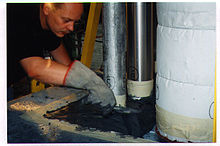mortar
Mortar (from the Latin mortarium "mortar", "mortar vessel"; regional also food , m. ) Is a building material that consists of a binding agent (e.g. lime or cement ), aggregate with a maximum grain size of 4 mm and added water , possibly also of concrete additives and additives , and hardened by chemical reaction of the binder. One parameter for the composition is the water solids value . The mortar is primarily used to connect masonry stonesand for plastering walls and ceilings. It is manufactured either in the factory or on site at the construction site.
history
The development of mortar dates back to ancient times. The Romans developed the building material opus caementitium , a mixture of rubble or crushed brick ("Caementum"), binding agent ("Mortar") and water to produce a kind of artificial stone. Opus caementitium is now regarded as the forerunner of concrete , but today's mortar has also developed from this ancient building material. In contrast to concrete, the aggregates used are finer, there is no addition of larger rubble stones.
Classification
Functional
By type of use
A distinction is made according to its function or use:
- Masonry mortar for making masonry
- Plaster mortar for plastering walls and ceilings
- Fire protection mortar for fire-resistant seals
- Synthetic resin mortar , consisting of unsaturated polyester resin , methacrylate resin or epoxy resin
- Grout for the subsequent jointing of tiles , facing bricks , exposed brickwork and paving stones
- Screed mortar for producing a screed as a floor or basis for the floor covering
- Grouting mortar or casting mortar for grouting anchorages , holes and gaps
- Swelling mortar for form -fitting or force-fit filling, filling and lining of cavities or for underlaying components
- Injection mortar for filling cracks
- Leveling compounds for leveling height differences and unevenness
- Water mortar with high resistance to aggressive water and hardening under water
- mineral sealing slurry for sealing floors and walls
Mortar is also used for thermal insulation or for fastening cladding elements. Another area of application is the use of cement mortar for lining steel pipes as protection against corrosion from aggressive media.
Fire protection mortar

In Germany, fire protection mortars are subject to approval by the German Institute for Building Technology . These are special building materials that are subject to external supervision by the building authorities because they are used to create partitions that must be proven to have a certain fire resistance class . The fire protection trade is part of the "WKSB" (heat, cold, sound and fire protection ), i.e. the insulation trade. The relevant industry associations for this are in Germany the Quality Association for Fire Protection in Expansion and in the USA and Canada the Firestop Contractors International Association and the International Firestop Council .
Aggregate
The most common aggregate for mortar is sand, but other materials, such as fine gravel or wood chips, can be used in certain cases. The largest grain size of the aggregate is 4 mm. In addition to its use, cement mortar mostly differs from concrete because of its small grain size . Some mortar binders can also be used without aggregate, i.e. only with water.
binder
Mortar can be made with mineral binders such as lime, cement , gypsum , anhydrite , magnesite and clay , plaster and wall binders or with organic binders (i.e. plastics ).
Curing
The binding agent hardens either through physical (drying, for example with clay) or chemical processes:
- In air mortar , the binder can only be exposed to air, e.g. B. by drying or by reaction with carbon dioxide , harden.
- Water mortar or hydraulic mortar also hardens under water.
Mortar groups
A new set of standards has been in force for plastering mortar since 2003:
DIN-EN 998-1 (09/2003)
Specification for mortar in masonry construction
The plaster mortar groups PI, PII, PIII according to DIN 18550 no longer exist. The new European standard applies to factory-made plastering mortars. It differentiates according to the type of properties and / or intended use
- Normal mortar (GP)
- Light mortar (LW)
- Fine plaster mortar (CR)
- Single-layer plaster mortar for outside (OC)
- Restoration plaster mortar (R)
- Thermal insulation plaster mortar (T)
Classification according to the old DIN 18550
- MG 1 - lime mortar , mixture of sand and slaked lime ( slaked lime , fat lime or milk of lime ); The quick lime is produced by thermal decomposition of calcium carbonate (see technical lime cycle and lime burning ), direct processing is called hot lime mortar
- MG 2 - Lime cement / hydraulic mortar and lime cement mortar (mixture of sand, lime / hydrated lime and cement)
- MG 2a - lime cement mortar
- MG 3 - cement mortar (mixture of sand and cement)
- MG 3a - cement mortar , = 20 N / mm 2
- MG 4 - gypsum mortar (mixture of sand and plaster)
Norms and standards
- DIN 1053 - masonry
- DIN 18550 - plaster and plaster systems
Special types
Web links
Individual evidence
- ^ Dietmar Grütze: Building Lexicon . Carl Hanser Verlag, Munich 2007, ISBN 3-446-40472-4 , p. 181 .
- ^ Fritz Scheidegger: From the history of building technology . Birkhäuser, Basel 1994, ISBN 3-7643-5069-5 , p. 75 .
- ^ A. Beuth and M. Beuth: Lexikon Bauwesen . Deutsche Verlags-Anstalt, Munich 2001, ISBN 3-421-03242-4 , pp. 108 .
- ^ Hans-Gustav Olshausen: VDI-Lexikon civil engineering . Springer-Verlag, Berlin Heidelberg 1991, ISBN 978-3-662-30425-9 , pp. 652 .
- ↑ Mannesmann Research Reports, No. 770/1978 by B. Heinrich, H. Hildebrand, M. Schulze, W. Schenk , in: 3R international, 17th year, issue 7, July 1978, pp. 448–459.


